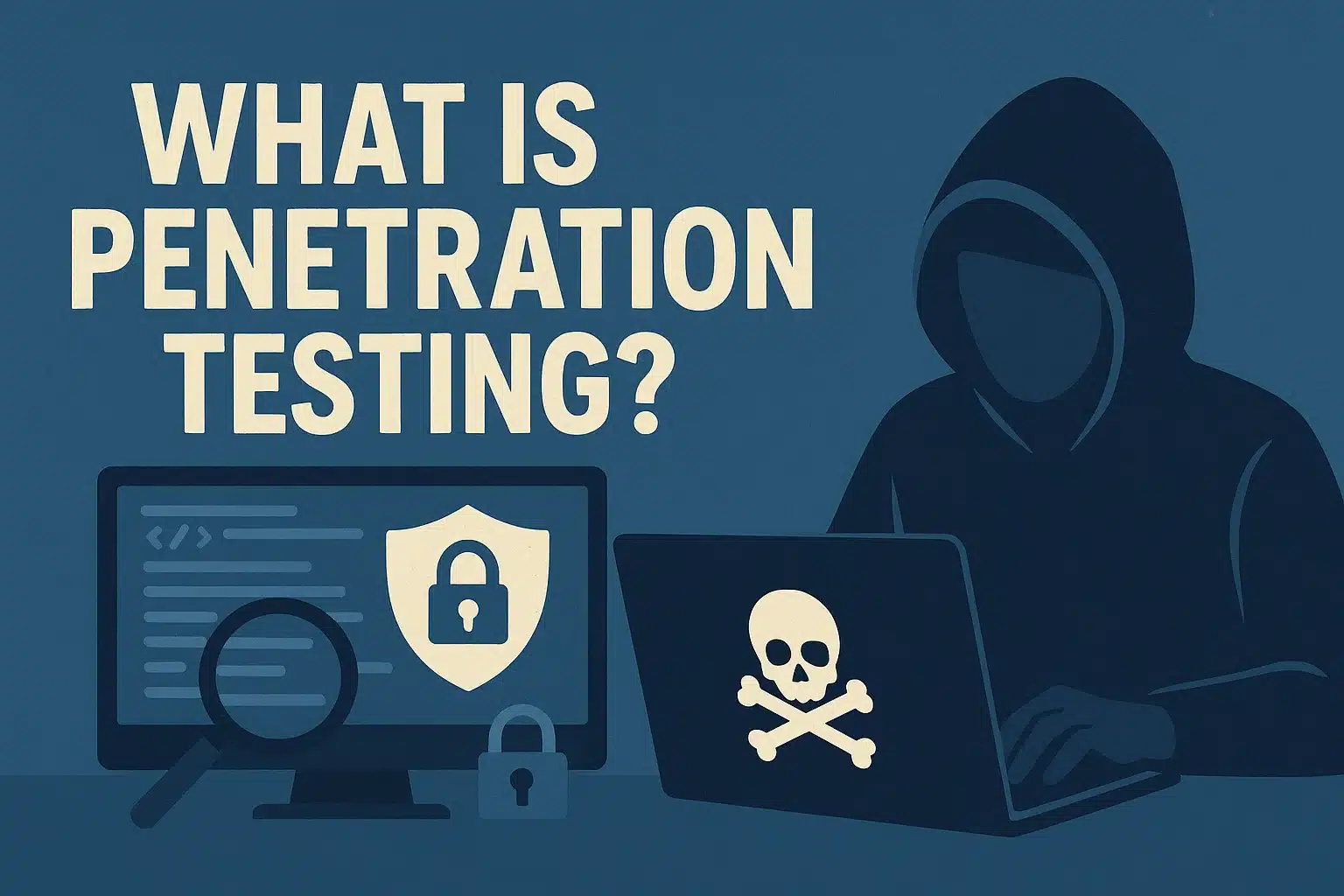Daily cyberattacks targeting Microsoft customers have reached a staggering 600 million.
The current situation requires businesses to stop asking whether their systems will be attacked, as attackers have already transitioned to focusing on when they will strike.
To mitigate this risk, enterprises use penetration testing as a methodical approach through fake hacking attempts to expose security problems that RomanLANG detects.
The article explains penetration testing techniques and their methodologies, describing their role in helping organizations create resilient cybersecurity systems.
What is Penetration Testing?
Penetration testing, also known as pen testing or ethical hacking, represents a proactive cybersecurity approach that enables authorized professionals to simulate real-world cyberattacks on systems, networks, and applications.
A vital objective is to identify weaknesses before criminals can exploit them, thereby evaluating the current protection systems in place.
Security experts conduct penetration tests by employing various attack methods and devices to identify system weaknesses that arise from misconfigurations, software issues, and human errors. Security tests exist for web applications, as well as networks and human factors, such as social engineering, among others.
Organizations that perform penetration tests gain valuable insights into their security posture and identify which vulnerabilities require immediate attention to build stronger defense capabilities for their systems.
Ethical Hacking Course: Master Hacking Techniques
Enroll in our Ethical Hacking course to learn the latest hacking techniques and cybersecurity skills. Become an expert in ethical hacking today!
Types of Penetration Testing
Penetration Testing Types, Focus Areas, and Purposes:
Network Penetration Testing
- Focus Area: Internal and external network infrastructure
- Purpose: Develop a security solution to identify vulnerabilities and weaknesses in network devices, servers, and services, thereby preventing unauthorized access to systems and data theft.
Web Application Penetration Testing
- Focus Area: Web applications and APIs
- Purpose: Identify SQL injection threats while detecting both cross-site scripting (XSS) vulnerabilities and authentication defects.
Mobile Application Penetration Testing
- Focus Area: Mobile apps on iOS and Android platforms
- Purpose: Check mobile applications for security flaws such as insecure data storage and unauthorized access.
Wireless Penetration Testing
- Focus Area: Wi-Fi networks and wireless protocols
- Purpose: Detect encryption weaknesses and illegitimate wireless access points in network systems.
Social Engineering Testing
- Focus Area: Human factors and organizational policies
- Purpose: Evaluate employees' vulnerability to exploitation tactics, such as phishing and pretexting.
Physical Penetration Testing
- Focus Area: Physical security controls and facilities
- Purpose: Determine how well access restrictions and physical barriers stop unauthorized entry.
Cloud Penetration Testing
- Focus Area: Cloud infrastructure and services
- Purpose: Determine if cloud environments contain configuration settings issues while assessing insecure interface connections and data visibility threats.
Red Team Assessment
- Focus Area: Comprehensive attack simulation
- Purpose: Run simulations of actual cyberattacks to evaluate defensive readiness throughout all security systems.
Black Box Testing
- Focus Area: External perspective with no prior knowledge
- Purpose: Detect vulnerabilities by simulating an external attacker with no insider knowledge.
White Box Testing
- Focus Area: Complete knowledge of systems and source code
- Purpose: Conduct thorough testing to uncover fundamental weaknesses in the system architecture.
Gray Box Testing
- Focus Area: Limited knowledge, simulating insider threats
- Purpose: Evaluate potential insider threats and external attacks through a combination of black and white box testing with internal insights.
Penetration Testing Process
1. Planning & Scoping
During the planning stage, the penetration test begins by establishing the testing framework, which specifies performance targets along with the operational boundaries. Key activities include:
- The organizational goal requires identifying all target systems, alongside their associated applications and network components.
- Establishing testing boundaries and limitations.
- Obtaining necessary legal agreements includes the execution of Non-Disclosure Agreements (NDAs) together with authorization letters.
Planning phases ensure that testing methods align with both organizational targets and fulfill legal and ethical requirements.
2. Reconnaissance
During this phase, testers systematically gather information about the target environment while looking for possible points of access. Reconnaissance can be:
- Collecting data without direct interaction, such as through public records, social media, and domain registries.
- Testers employ active methodologies, such as using Nmap or Nessus, to interact with target systems and identify accessible ports and services.
Understanding reconnaissance techniques is a fundamental requirement for those learning to become ethical hackers. To gain insights into these methods, you can enroll in the Free Introduction to Ethical Hacking course.
3. Vulnerability Identification
The collected information serves as the basis for testers to identify weaknesses within target systems. This involves:
- Security testers identify vulnerabilities using automated inspection systems, such as OpenVAS or Nessus.
- Security professionals evaluate systems through manual testing to identify complex security issues.
Your understanding at this phase needs to include fundamental concepts related to cybersecurity threats. Free advanced cybersecurity courses, such as Cyber Security Threats and Advanced Cyber Security Threats and Governance, help you develop stronger capabilities in detecting vulnerabilities.
4. Exploitation
Testers use this primary phase to implement identified vulnerabilities, thereby measuring their severity. Techniques may include:
- Testers attempt to launch SQL injection attacks and execute cross-site scripting (XSS) attacks.
- Social engineering tactics enable attackers to extract secret information from users through deceptive manipulation methods.
5. Post-Exploitation Analysis
Testers evaluate the achieved access, along with its organizational impact, following a successful exploitation. This includes:
- Testers need to evaluate the extent of data accessibility they obtained.
- Assessment of continuous system entry possibility.
- The testers assess whether network employees can move across departments during their exploitation.
By performing this analysis, organizations gain insights into the severity of damage that attackers in real-world situations could cause.
6. Reporting & Remediation
The last phase involves creating an extensive document that includes:
- Researchers discover system vulnerabilities by using the techniques hackers employ to exploit these weaknesses.
- The potential impact of each vulnerability.
- The report provides precise recommendations for addressing the documented issues.
The process of effective reporting enables stakeholders to understand the risks, thereby allowing them to deploy proper security measures.
Penetration Testing vs. Vulnerability Scanning
| Aspect | Penetration Testing | Vulnerability Scanning |
| Purpose | Simulates real-world attacks to exploit vulnerabilities and assess the potential impact of security breaches. | Identifies known vulnerabilities in systems, applications, and networks without exploiting them. |
| Approach | Ethical hackers perform manual and often intrusive testing to uncover complex security issues. | Automated and non-intrusive scanning using tools to detect known vulnerabilities. |
| Depth of Analysis | Provides in-depth analysis by attempting to exploit vulnerabilities, revealing potential damage and access levels. | Offers surface-level detection of vulnerabilities without assessing their exploitability. |
| Frequency | Conducted periodically (e.g., annually or after significant system changes) due to its comprehensive nature. | Performed regularly (e.g., weekly, monthly) to continuously monitor and identify new vulnerabilities. |
| Required Expertise | Requires skilled cybersecurity professionals with knowledge of attack techniques and system architectures. | Can be executed by IT staff with minimal training, utilizing automated tools. |
| Output | Detailed reports outlining exploited vulnerabilities, methods used, and recommendations for remediation. | Generates lists of detected vulnerabilities with severity ratings and suggested fixes. |
| Cost | Higher cost due to the manual effort and expertise involved. | Lower cost as it relies on automated tools and requires less human intervention. |
| Use Cases | Ideal for assessing the effectiveness of security measures, compliance testing, and understanding potential real-world attack impacts. | Suitable for routine security checks, ensuring systems are up-to-date with patches, and maintaining compliance standards. |
| Examples of Tools | Metasploit, Burp Suite, Kali Linux. | Nessus, OpenVAS, Qualys. |
| Compliance Relevance | Often required for compliance with standards like PCI DSS, HIPAA, and ISO 27001 to demonstrate robust security practices. | Helps maintain compliance by regularly identifying and addressing known vulnerabilities. |
Essential Penetration Testing Tools
- Metasploit
- Type: Exploit Framework
- Purpose: Automates the process of discovering, exploiting, and validating vulnerabilities.
- Use Case: Ideal for simulating attacks and testing the effectiveness of security defenses.
- Nmap (Network Mapper)
- Type: Network Scanning Tool
- Purpose: Discovers hosts and services on a computer network, providing insights into open ports and services.
- Use Case: Useful for network inventory, managing service upgrade schedules, and monitoring host or service uptime.
- Burp Suite
- Type: Web Vulnerability Scanner
- Purpose: Identifies and exploits vulnerabilities in web applications.
- Use Case: Effective for testing web application security by intercepting and modifying HTTP requests.
- Wireshark
- Type: Network Protocol Analyzer
- Purpose: Captures and analyzes the data traveling into and out of a system.
- Use Case: Essential for network troubleshooting, analysis, and software and protocol development.
- John the Ripper
- Type: Password Cracking Tool
- Purpose: Detects weak passwords by performing dictionary attacks.
- Use Case: Used to assess the strength of password policies and recover lost passwords.
- Nessus
- Type: Vulnerability Scanner
- Purpose: Scans systems for known vulnerabilities, misconfigurations, and compliance issues.
- Use Case: Ideal for regular network scans to identify potential security risks.
- Kali Linux
- Type: Penetration Testing Distribution
- Purpose: Provides a comprehensive suite of tools for penetration testing and security auditing.
- Use Case: A preferred operating system for ethical hackers, preloaded with numerous security tools.
Penetration Testing Techniques
- Reconnaissance - Organizations need to collect information from their target system to identify possible points of access.
- Scanning- Finding available network entrances and evaluation of accessible ports with their corresponding services and security weakness detection.
- Exploitation - The objective is to utilize discovered system weaknesses to bypass security barriers without authorization.
- Post-Exploitation: Evaluation of damage from exploitation events combined with continued access preservation for subsequent examination purposes.
- Reporting - The processes include documentation of findings, as well as risk assessments and removal recommendations.
Penetration testing practitioners should proceed to the Online Cyber Security Course for advanced education after completing their current studies. Cybersecurity instruction from the program includes comprehensive training in penetration testing methodology and validated, practical assessments conducted through multiple protocols.
Conclusion
Penetration testing functions beyond being a vague cybersecurity term because it represents an organized system of protecting valuable digital resources. Organizations gain protection against cyber threats by conducting simulated attacks, which help them identify and remediate vulnerabilities before harmful actors can exploit them.






